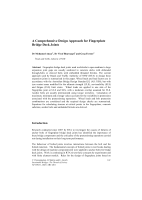Bridges

- Publication no: ABC-DES002-11
- Published: 31 October 2011
- PDF (free) Download
Fingerplate bridge deck joints used worldwide to span medium to large expansion joint gaps are usually anchored to concrete decks with debonded through-bolts or sleeved bolts with embedded threaded ferrules. The current approach used by Roads and Traffic Authority of NSW (RTA) to design these expansion joints is summarised in this paper. Wheel loads and load factors are in accordance with the Australian Bridge Design Standard (AS 5100), but with tyre contact areas modified for the ultimate strength (ULS), serviceability (SLS) and fatigue (FLS) limit states. Wheel loads are applied to one side of the fingerplate joint at ULS and SLS, with a moderate overlap assumed for FLS. Anchor bolts are usually pretensioned using torque wrenches. Calculation of maximum, minimum and average values accounts for the variability in pretensions associated with the pretensioning operations. Wheel loads and bolt pretension combinations are considered and the required design checks are summarised. Equations for calculating stresses at critical points in the fingerplates, concretesubstrate, anchor bolts and embedded ferrules are derived.
